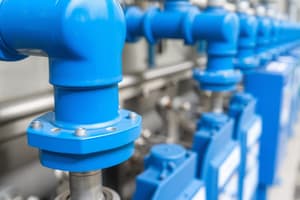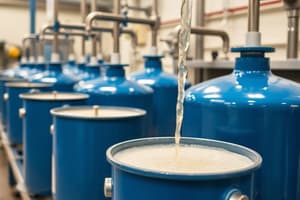Podcast
Questions and Answers
What is the optimal temperature range for biodiesel production to ensure methanol has not reached its boiling point?
What is the optimal temperature range for biodiesel production to ensure methanol has not reached its boiling point?
- 65 °C to 70 °C
- 70 °C to 75 °C
- 55 °C to 60 °C
- 60 °C to 65 °C (correct)
What role do agitation and baffles play in the biodiesel reactor?
What role do agitation and baffles play in the biodiesel reactor?
- They contribute to the homogenity of temperature. (correct)
- They increase the boiling point of methanol.
- They reduce the overall reaction time.
- They cool down the reactor contents.
At what RPM agitation does the temperature within the biodiesel reactor achieve homogeneity?
At what RPM agitation does the temperature within the biodiesel reactor achieve homogeneity?
- 200 rpm and 300 rpm
- 100 rpm and 200 rpm (correct)
- 50 rpm and 150 rpm
- 300 rpm and 400 rpm
What is the standard deviation value of temperature variation in the biodiesel reactor?
What is the standard deviation value of temperature variation in the biodiesel reactor?
Which statement accurately describes the importance of temperature in the biodiesel production process?
Which statement accurately describes the importance of temperature in the biodiesel production process?
What phenomenon occurs due to the insertion of baffles in large-scale reactor tanks?
What phenomenon occurs due to the insertion of baffles in large-scale reactor tanks?
What is the significance of measuring temperature at three positions in the biodiesel reactor?
What is the significance of measuring temperature at three positions in the biodiesel reactor?
What is necessary for ensuring that the biodiesel reaction takes place entirely within the reactor?
What is necessary for ensuring that the biodiesel reaction takes place entirely within the reactor?
What process is described for producing biodiesel?
What process is described for producing biodiesel?
At what rpm was the total glycerol content of biodiesel within the acceptable Indonesian standard?
At what rpm was the total glycerol content of biodiesel within the acceptable Indonesian standard?
Which temperature range is indicated for the acid value of biodiesel from all treatments?
Which temperature range is indicated for the acid value of biodiesel from all treatments?
What was the yield percentage of biodiesel at 1000 rpm?
What was the yield percentage of biodiesel at 1000 rpm?
How does temperature influence the quality of biodiesel production during transesterification?
How does temperature influence the quality of biodiesel production during transesterification?
What pattern was observed regarding biodiesel yield across various experiments?
What pattern was observed regarding biodiesel yield across various experiments?
What was the range of the acid values for biodiesel across all treatments, except at 1000 rpm?
What was the range of the acid values for biodiesel across all treatments, except at 1000 rpm?
What was the total glycerol content across all treatments on average?
What was the total glycerol content across all treatments on average?
What temperature range was maintained during the biodiesel production process?
What temperature range was maintained during the biodiesel production process?
Which method was used to purify the biodiesel after the transesterification reaction?
Which method was used to purify the biodiesel after the transesterification reaction?
What is indicated as the desirable pH value for the wastewater to confirm the removal of catalyst from biodiesel?
What is indicated as the desirable pH value for the wastewater to confirm the removal of catalyst from biodiesel?
At what time duration is the transesterification reaction assumed to be completed?
At what time duration is the transesterification reaction assumed to be completed?
How was the methyl ester content of biodiesel measured?
How was the methyl ester content of biodiesel measured?
What capacity does the reactor tank used for biodiesel production have?
What capacity does the reactor tank used for biodiesel production have?
What component of the reactor is responsible for maintaining the temperature during biodiesel production?
What component of the reactor is responsible for maintaining the temperature during biodiesel production?
Which of the following components is NOT included in the design of the biodiesel reactor?
Which of the following components is NOT included in the design of the biodiesel reactor?
Flashcards
Biodiesel Reactor
Biodiesel Reactor
A cylindrical reactor designed for biodiesel production.
Agitator
Agitator
A device (like a helical screw) that mixes the liquid in the reactor.
Reactor Temperature
Reactor Temperature
The temperature of the liquid within the reactor; important for the reaction and product quality during biodiesel production.
Optimal Temperature
Optimal Temperature
Signup and view all the flashcards
Homogenous Temperature
Homogenous Temperature
Signup and view all the flashcards
Agitation (RPM)
Agitation (RPM)
Signup and view all the flashcards
Temperature Distribution
Temperature Distribution
Signup and view all the flashcards
Standard Deviation
Standard Deviation
Signup and view all the flashcards
Standard Deviation of Liquid Temperature
Standard Deviation of Liquid Temperature
Signup and view all the flashcards
Temperature Distribution in Reactor
Temperature Distribution in Reactor
Signup and view all the flashcards
Biodiesel Quality Standard
Biodiesel Quality Standard
Signup and view all the flashcards
Total Glycerol
Total Glycerol
Signup and view all the flashcards
Acid Value
Acid Value
Signup and view all the flashcards
Biodiesel Yield
Biodiesel Yield
Signup and view all the flashcards
Optimal Agitation Speed
Optimal Agitation Speed
Signup and view all the flashcards
Transesterification Reaction
Transesterification Reaction
Signup and view all the flashcards
Biodiesel Production Temperature
Biodiesel Production Temperature
Signup and view all the flashcards
Agitation Rotation Values
Agitation Rotation Values
Signup and view all the flashcards
Transesterification Time
Transesterification Time
Signup and view all the flashcards
Glycerol Separation Method
Glycerol Separation Method
Signup and view all the flashcards
Catalyst Removal Method
Catalyst Removal Method
Signup and view all the flashcards
Neutralization Check
Neutralization Check
Signup and view all the flashcards
Biodiesel Quality Tests
Biodiesel Quality Tests
Signup and view all the flashcards
Methyl Ester Content Measurement
Methyl Ester Content Measurement
Signup and view all the flashcards
Study Notes
Biodiesel Reactor Design and Performance Test
- A biodiesel reactor model using a helical screw agitator and baffles was designed.
- The helical screw type was chosen for its ability to agitate viscous liquids with low energy, while baffles were used to create uniform mixing.
- The research aimed to produce a biodiesel reactor model and determine the optimal operating parameters for biodiesel production.
- A cylindrical biodiesel reactor with a height of 300mm and a diameter of 168mm was used.
- The helical screw agitator had four screws and four baffles were installed along the reactor's wall.
- Biodiesel was produced using a catalytic method with a 1.5% w/w KOH catalyst at temperatures ranging from 60°C to 65°C for 60 minutes.
- The saponification value analysis showed that the biodiesel contained 99% w/w methyl ester.
- The optimal operating conditions for biodiesel production were achieved at 100 rpm, meeting the quality standards and minimizing energy consumption.
Methodology
- Materials and apparatus were divided into two categories: design and performance testing.
- Design materials included stainless steel, hollow iron, electric welding machine, grindstone, drilling machine, lathe, etc.
- Performance testing materials included palm oil, methanol, KOH, phenolphtalein indicator, chemical glassware, and an electrical balance.
Reactor Design
- The reactor consisted of a cylindrical reactor, helical screw agitator, four baffles, an electric heater, motor, temperature controller, motor rotational speed controller, and a cantilever/frame.
- The cylindrical reactor had a diameter of 168 mm and a height of 300 mm.
- The helical screw agitator contained four blades.
- The baffles were installed along the reactor's walls.
- The electric heater was located below the agitator.
- The dimensions of the reactor's components are described in tables.
Performance Test
- Liquid temperature distribution within the reactor was measured at different speeds and locations.
- The optimal temperature range for the transesterification reaction was 60-65°C.
- The results showed that the helical screw agitator and baffles effectively mixed the reactants at a high yield (ranging from 80-92%) without variation as the speed increased.
- Standard deviation values of liquid temperatures were low with variation of 0 °C to 0.25°C, demonstrating uniform temperatures.
- All treatments had total glycerol of 0.28%, except at 100 rpm, which had 0.12%. (values below 0.24% are preferred)
Studying That Suits You
Use AI to generate personalized quizzes and flashcards to suit your learning preferences.




